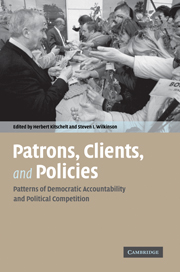Book contents
- Frontmatter
- Contents
- List of figures
- List of tables
- Acknowledgments
- List of contributors
- 1 Citizen–politician linkages: an introduction
- 2 Meet the new boss, same as the old boss? The evolution of political clientelism in Africa
- 3 Monopoly and monitoring: an approach to political clientelism
- 4 Counting heads: a theory of voter and elite behavior in patronage democracies
- 5 Explaining changing patterns of party–voter linkages in India
- 6 Politics in the middle: mediating relationships between the citizens and the state in rural North India
- 7 Rethinking economics and institutions: the voter's dilemma and democratic accountability
- 8 Clientelism and portfolio diversification: a model of electoral investment with applications to Mexico
- 9 From populism to clientelism? The transformation of labor-based party linkages in Latin America
- 10 Correlates of clientelism: political economy, politicized ethnicity, and post-communist transition
- 11 Political institutions and linkage strategies
- 12 Clientelism in Japan: the importance and limits of institutional explanations
- 13 The demise of clientelism in affluent capitalist democracies
- 14 A research agenda for the study of citizen–politician linkages and democratic accountability
- References
- Index
5 - Explaining changing patterns of party–voter linkages in India
Published online by Cambridge University Press: 27 October 2009
- Frontmatter
- Contents
- List of figures
- List of tables
- Acknowledgments
- List of contributors
- 1 Citizen–politician linkages: an introduction
- 2 Meet the new boss, same as the old boss? The evolution of political clientelism in Africa
- 3 Monopoly and monitoring: an approach to political clientelism
- 4 Counting heads: a theory of voter and elite behavior in patronage democracies
- 5 Explaining changing patterns of party–voter linkages in India
- 6 Politics in the middle: mediating relationships between the citizens and the state in rural North India
- 7 Rethinking economics and institutions: the voter's dilemma and democratic accountability
- 8 Clientelism and portfolio diversification: a model of electoral investment with applications to Mexico
- 9 From populism to clientelism? The transformation of labor-based party linkages in Latin America
- 10 Correlates of clientelism: political economy, politicized ethnicity, and post-communist transition
- 11 Political institutions and linkage strategies
- 12 Clientelism in Japan: the importance and limits of institutional explanations
- 13 The demise of clientelism in affluent capitalist democracies
- 14 A research agenda for the study of citizen–politician linkages and democratic accountability
- References
- Index
Summary
When India attained independence in 1947, it was already in many respects a clientelistic polity. The British had strengthened their own colonial rule by providing land and other goods to important social groups and their leaders, and they also institutionalized ascriptive criteria such as caste and religion as authoritative ways for the state to allocate jobs, positions in state-funded educational establishments, and seats in parliamentary and provincial assemblies (Wilkinson 2004). The Congress Party, far from being an “external party” of the type characterized by Martin Shefter – one bent on cleaning up the mill of patronage – had itself been transformed by more than twenty years in control of the various provincial and local assemblies set up by the British after 1919 to quiet demands for independence. Congress's control of these assemblies, characterized by one historian as “enormous pools of patronage” (Washbrook 1973), meant that the party acted more like one of Shefter's internally mobilized parties – using the state administration and state patronage to build support and reward allies – than an external programmatic party. In Calcutta, the Congress used its control of the municipal corporation after 1923 to strengthen its position, so that by independence perhaps 70 percent of the corporation's staff were party workers or their family members (Weiner 1967: 328).The considerable spending power the local and provincial assemblies eventually controlled, combined with the prospect of even greater power when the British left, also attracted many members to Congress in the decade before independence whose primary concern was less ideological than material.
Information
- Type
- Chapter
- Information
- Patrons, Clients and PoliciesPatterns of Democratic Accountability and Political Competition, pp. 110 - 140Publisher: Cambridge University PressPrint publication year: 2007
Accessibility standard: Unknown
Why this information is here
This section outlines the accessibility features of this content - including support for screen readers, full keyboard navigation and high-contrast display options. This may not be relevant for you.Accessibility Information
- 63
- Cited by
